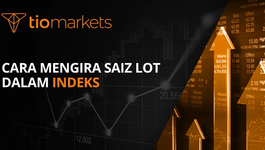How to Trade Indices?
BY TIOmarkets
|Mei 16, 2024Trading indices can be a lucrative venture for those who understand how they work. But where do you start? In this article, we'll guide you through the process of trading indices, from understanding the basics to developing trading strategies and managing risks. So let's dive in and discover how you can start trading indices today.
Understanding the Basics of Indices
If you're new to indices, it's essential to grasp their fundamentals. In simple terms, an index represents a group of stocks that are grouped together based on various factors, such as industry, size, or region. Indices serve as indicators of the overall performance of a specific market or sector.
Indices provide investors with a way to track the performance of a specific segment of the market without having to analyze each individual stock. They offer a broad view of how a particular group of stocks is faring, making it easier for investors to gauge market trends and make informed decisions.
What are Indices?
Indices are like snapshots of the stock market, giving you an overview of how a specific group of stocks is performing. Some well-known indices include the S&P 500, Dow Jones Industrial Average, and Nasdaq Composite.
Each index has its own methodology for selecting and weighting the stocks it includes. For example, the S&P 500 is a market-capitalization-weighted index, meaning that companies with higher market capitalizations have a greater impact on the index's performance.
Importance of Indices in Trading
Indices play a vital role in trading as they allow you to monitor the performance of an entire market or sector without having to analyze each individual stock. By keeping tabs on indices, traders can identify trends, make informed decisions, and potentially profit from market movements.
Traders often use indices as benchmarks to measure the performance of their own investments. For instance, if an investor's portfolio is consistently underperforming compared to a relevant index, it may indicate the need for a reassessment of their investment strategy.
Preparing to Trade Indices
Before you start trading indices, it's crucial to have the right tools and a solid trading plan in place.
Trading indices can be an exciting venture, offering exposure to a diverse range of markets and sectors. It's essential to understand the nuances of each index you plan to trade, as they can be influenced by various factors such as economic indicators, geopolitical events, and market sentiment.
Necessary Tools for Trading Indices
To trade indices effectively, you'll need a reliable trading platform or brokerage account. Ensure that the platform offers real-time data, technical analysis tools, and access to a wide range of indices.
Additionally, having a good understanding of market fundamentals and technical analysis can greatly enhance your trading decisions. Fundamental analysis involves studying economic data, corporate earnings, and news events that can impact the index's performance. On the other hand, technical analysis focuses on price charts and patterns to predict future price movements.
Developing a Trading Plan
A trading plan acts as your roadmap in the world of indices trading. It should outline your trading goals, risk tolerance, entry and exit strategies, and money management rules. Stick to your plan and remain disciplined to increase your chances of success.
Moreover, staying informed about global economic trends and market developments is crucial for successful index trading. Keeping an eye on major news events, central bank announcements, and geopolitical tensions can help you anticipate market movements and make informed trading decisions.
Analyzing Indices
Analyzing indices is crucial to make informed trading decisions. There are two primary methods of analysis: fundamental analysis and technical analysis.
Understanding how indices function within the broader financial market is essential for successful trading. Indices represent a basket of stocks that are grouped together to provide a snapshot of a particular sector, market, or economy. By analyzing indices, investors can gain insights into the overall health and performance of the underlying assets.
Fundamental Analysis of Indices
When conducting fundamental analysis, you evaluate the underlying economic factors that may impact an index's performance. This includes analyzing economic indicators, company news, geopolitical events, and monetary policies of central banks. Fundamental analysis seeks to determine the intrinsic value of an index by examining factors that could influence its future movements.
Technical Analysis of Indices
Technical analysis involves studying historical price charts and using various indicators to predict future price movements. Traders utilize tools such as moving averages, relative strength index (RSI), and Fibonacci retracement levels to identify potential support and resistance levels. By interpreting chart patterns and market trends, technical analysis provides traders with valuable insights into the probable direction of an index's price movements.
Trading Indices Strategies
Now that you understand the basics and have analyzed indices, it's time to explore different trading strategies.
When it comes to trading indices, there are various strategies that traders can employ to navigate the dynamic and ever-changing market landscape. In addition to day trading and swing trading, there are other approaches that cater to different risk appetites and time horizons.
Day Trading Indices
Day trading involves opening and closing positions within the same trading day to capitalize on short-term price fluctuations. Day traders often rely on technical analysis and employ strategies such as scalping or breakout trading.
Scalping, a popular day trading strategy, focuses on making small profits from numerous trades throughout the day. Traders using this approach aim to capitalize on minor price movements and typically hold positions for a very short period, sometimes just seconds or minutes.
Breakout trading, another common day trading strategy, involves entering a trade when the price breaks out of a defined range or pattern. Traders using this strategy believe that the breakout indicates a strong momentum shift, which can lead to significant price movements in the direction of the breakout.
Swing Trading Indices
Swing trading aims to capture larger price movements over a few days to weeks. Traders look for well-defined trends and use technical indicators to identify potential entry and exit points.
Unlike day trading, swing trading allows traders to hold positions for longer periods, taking advantage of medium-term price fluctuations. This approach requires patience and discipline, as traders must wait for the market to confirm their analysis before entering or exiting a trade.
Swing traders often use a combination of technical analysis tools, such as moving averages, Fibonacci retracements, and trendlines, to identify potential entry and exit points. By analyzing historical price data and market trends, swing traders aim to capitalize on the ebb and flow of the market over a slightly longer time horizon.
Risk Management in Indices Trading
Risk management is crucial in any trading activity. Here are some essential considerations for managing risks when trading indices.
Understanding Risk and Reward
Before placing any trades, it's important to assess potential risks and rewards. Determine your risk tolerance and set realistic profit targets. Always remember that trading indices involves inherent risks, and losses are part of the game.
Implementing Stop Loss Orders
Stop loss orders are a risk management tool that allows you to set a predetermined exit point for a trade. By using stop loss orders, you can limit potential losses and protect your capital from significant downturns.
Trading indices can be an exciting and profitable endeavor when approached with knowledge and discipline. By understanding the basics, analyzing indices, implementing effective strategies, and managing risks, you can increase your chances of success in the world of indices trading. So start exploring and apply these principles to your own trading journey today!
Furthermore, it's important to diversify your portfolio when trading indices. Diversification helps spread risk across different assets, reducing the impact of a single asset's poor performance on your overall portfolio. This can be achieved by investing in a mix of indices from various sectors or regions, ensuring that your investments are not overly concentrated in one area.
Monitoring Market Trends
Keeping a close eye on market trends is essential for successful indices trading. By staying informed about economic indicators, geopolitical events, and other factors that can influence index prices, you can make more informed trading decisions. Utilizing technical analysis tools and staying up-to-date with market news can help you identify potential opportunities and risks in the market.
Start Trading Indices with TIOmarkets
Now that you're equipped with the knowledge of how to trade indices, it's time to put your skills into action. Join over 170,000 traders in more than 170 countries who have chosen TIOmarkets for their trading journey. With our extensive range of educational resources and step-by-step guides, you'll learn how to trade effectively across 300+ instruments in 5 markets, including Forex, indices, stocks, commodities, and futures.
Experience trading with low fees and robust support when you Create a Trading Account at TIOmarkets today.

Risk disclaimer: CFDs are complex instruments and come with a high risk of losing money rapidly due to leverage. You should consider whether you understand how CFDs work and whether you can afford to take the high risk of losing your money. Never deposit more than you are prepared to lose. Professional client’s losses can exceed their deposit. Please see our risk warning policy and seek independent professional advice if you do not fully understand. This information is not directed or intended for distribution to or use by residents of certain countries/jurisdictions including, but not limited to, USA & OFAC. The Company holds the right to alter the aforementioned list of countries at its own discretion.
Join us on social media

Behind every blog post lies the combined experience of the people working at TIOmarkets. We are a team of dedicated industry professionals and financial markets enthusiasts committed to providing you with trading education and financial markets commentary. Our goal is to help empower you with the knowledge you need to trade in the markets effectively.





